中国成人英语学习的焦虑变量分析
- 格式:pdf
- 大小:143.25 KB
- 文档页数:41
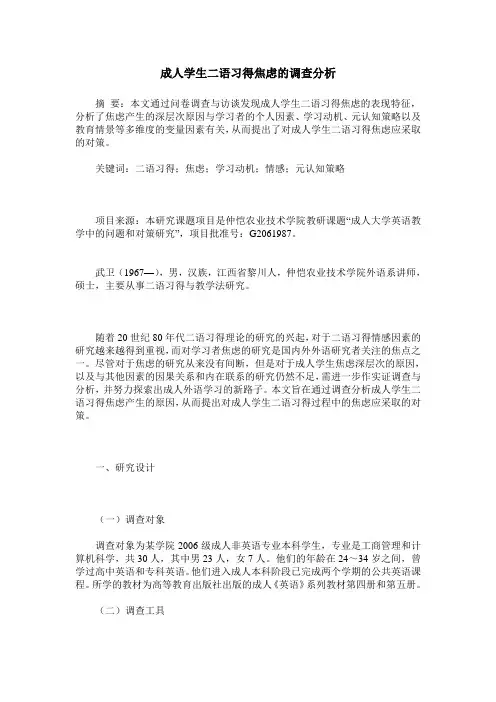
成人学生二语习得焦虑的调查分析摘要:本文通过问卷调查与访谈发现成人学生二语习得焦虑的表现特征,分析了焦虑产生的深层次原因与学习者的个人因素、学习动机、元认知策略以及教育情景等多维度的变量因素有关,从而提出了对成人学生二语习得焦虑应采取的对策。
关键词:二语习得;焦虑;学习动机;情感;元认知策略项目来源:本研究课题项目是仲恺农业技术学院教研课题“成人大学英语教学中的问题和对策研究”,项目批准号:G2061987。
武卫(1967—),男,汉族,江西省黎川人,仲恺农业技术学院外语系讲师,硕士,主要从事二语习得与教学法研究。
随着20世纪80年代二语习得理论的研究的兴起,对于二语习得情感因素的研究越来越得到重视,而对学习者焦虑的研究是国内外外语研究者关注的焦点之一。
尽管对于焦虑的研究从来没有间断,但是对于成人学生焦虑深层次的原因,以及与其他因素的因果关系和内在联系的研究仍然不足,需进一步作实证调查与分析,并努力探索出成人外语学习的新路子。
本文旨在通过调查分析成人学生二语习得焦虑产生的原因,从而提出对成人学生二语习得过程中的焦虑应采取的对策。
一、研究设计(一)调查对象调查对象为某学院2006级成人非英语专业本科学生,专业是工商管理和计算机科学,共30人,其中男23人,女7人。
他们的年龄在24~34岁之间,曾学过高中英语和专科英语。
他们进入成人本科阶段已完成两个学期的公共英语课程。
所学的教材为高等教育出版社出版的成人《英语》系列教材第四册和第五册。
(二)调查工具调查采用问卷调查和访谈的两种形式。
问卷调查参考了Horwitz (1986)设计的外语课堂学习焦虑量表,由20个问题组成,包括三个层面:学习焦虑、学习者个人现状和元认知学习策略。
问卷调查在课堂上随堂进行。
访谈是通过与部分调查对象面对面和书面交流的形式了解学生学习的焦虑状况。
二、结果与讨论(一)成人学生二语习得焦虑的表现特征1.语言焦虑。
问卷调查发现成人学生在二语习得听说读写语言技能方面存在焦虑。
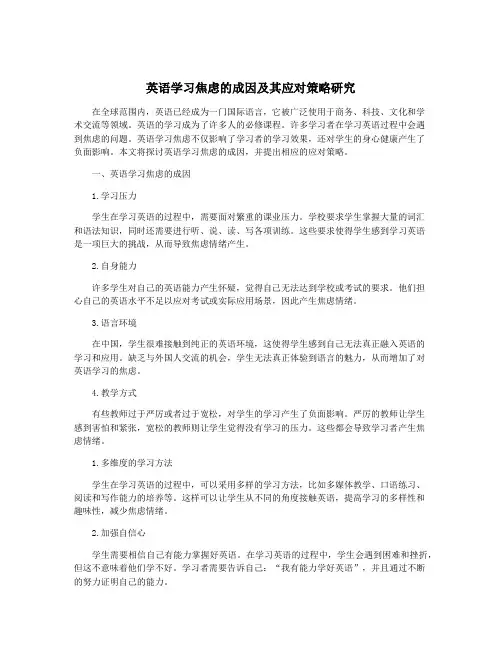
英语学习焦虑的成因及其应对策略研究在全球范围内,英语已经成为一门国际语言,它被广泛使用于商务、科技、文化和学术交流等领域。
英语的学习成为了许多人的必修课程。
许多学习者在学习英语过程中会遇到焦虑的问题。
英语学习焦虑不仅影响了学习者的学习效果,还对学生的身心健康产生了负面影响。
本文将探讨英语学习焦虑的成因,并提出相应的应对策略。
一、英语学习焦虑的成因1.学习压力学生在学习英语的过程中,需要面对繁重的课业压力。
学校要求学生掌握大量的词汇和语法知识,同时还需要进行听、说、读、写各项训练。
这些要求使得学生感到学习英语是一项巨大的挑战,从而导致焦虑情绪产生。
2.自身能力许多学生对自己的英语能力产生怀疑,觉得自己无法达到学校或考试的要求。
他们担心自己的英语水平不足以应对考试或实际应用场景,因此产生焦虑情绪。
3.语言环境在中国,学生很难接触到纯正的英语环境,这使得学生感到自己无法真正融入英语的学习和应用。
缺乏与外国人交流的机会,学生无法真正体验到语言的魅力,从而增加了对英语学习的焦虑。
4.教学方式有些教师过于严厉或者过于宽松,对学生的学习产生了负面影响。
严厉的教师让学生感到害怕和紧张,宽松的教师则让学生觉得没有学习的压力。
这些都会导致学习者产生焦虑情绪。
1.多维度的学习方法学生在学习英语的过程中,可以采用多样的学习方法,比如多媒体教学、口语练习、阅读和写作能力的培养等。
这样可以让学生从不同的角度接触英语,提高学习的多样性和趣味性,减少焦虑情绪。
2.加强自信心学生需要相信自己有能力掌握好英语。
在学习英语的过程中,学生会遇到困难和挫折,但这不意味着他们学不好。
学习者需要告诉自己:“我有能力学好英语”,并且通过不断的努力证明自己的能力。
3.创造语言环境学生可以通过参加英语角、英语演讲比赛、参加外语培训等方式,创造更多的英语学习和交流机会。
这样可以让学生感受到真实的语言环境,提高对英语学习的兴趣和积极性。
4.分阶段的学习目标学生在学习英语时,可以将学习目标分解成阶段性的小目标,每次完成一个小目标后,都可以感到一定的成就感。
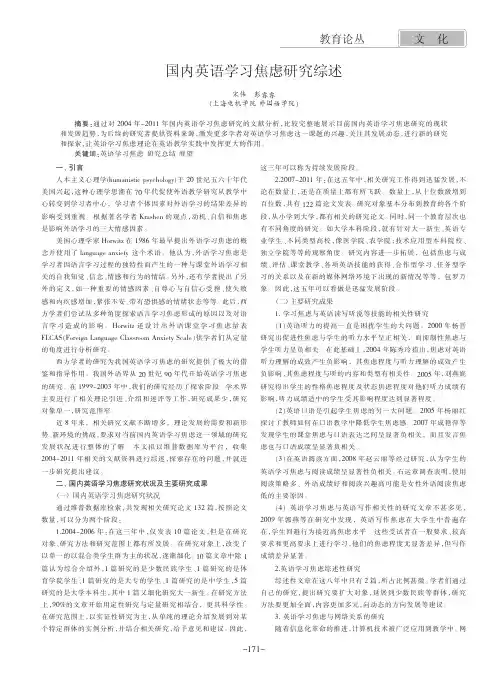
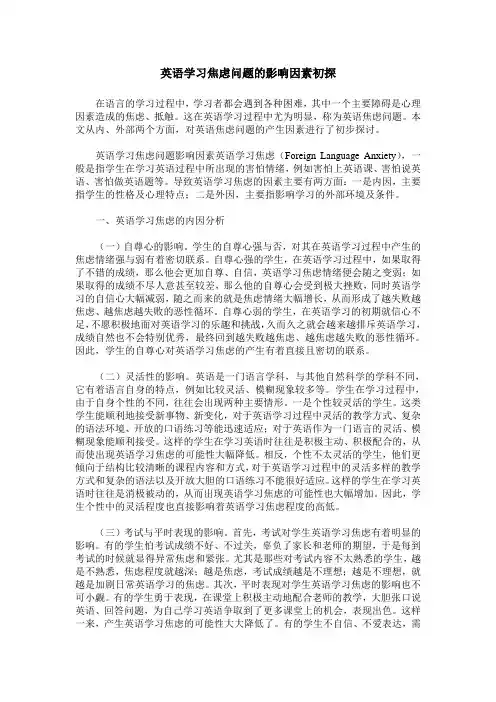
英语学习焦虑问题的影响因素初探在语言的学习过程中,学习者都会遇到各种困难,其中一个主要障碍是心理因素造成的焦虑、抵触。
这在英语学习过程中尤为明显,称为英语焦虑问题。
本文从内、外部两个方面,对英语焦虑问题的产生因素进行了初步探讨。
英语学习焦虑问题影响因素英语学习焦虑(Foreign Language Anxiety),一般是指学生在学习英语过程中所出现的害怕情绪,例如害怕上英语课、害怕说英语、害怕做英语题等。
导致英语学习焦虑的因素主要有两方面:一是内因,主要指学生的性格及心理特点;二是外因,主要指影响学习的外部环境及条件。
一、英语学习焦虑的内因分析(一)自尊心的影响。
学生的自尊心强与否,对其在英语学习过程中产生的焦虑情绪强与弱有着密切联系。
自尊心强的学生,在英语学习过程中,如果取得了不错的成绩,那么他会更加自尊、自信,英语学习焦虑情绪便会随之变弱;如果取得的成绩不尽人意甚至较差,那么他的自尊心会受到极大挫败,同时英语学习的自信心大幅减弱,随之而来的就是焦虑情绪大幅增长,从而形成了越失败越焦虑、越焦虑越失败的恶性循环。
自尊心弱的学生,在英语学习的初期就信心不足,不愿积极地面对英语学习的乐趣和挑战,久而久之就会越来越排斥英语学习,成绩自然也不会特别优秀,最终回到越失败越焦虑、越焦虑越失败的恶性循环。
因此,学生的自尊心对英语学习焦虑的产生有着直接且密切的联系。
(二)灵活性的影响。
英语是一门语言学科,与其他自然科学的学科不同,它有着语言自身的特点,例如比较灵活、模糊现象较多等。
学生在学习过程中,由于自身个性的不同,往往会出现两种主要情形。
一是个性较灵活的学生。
这类学生能顺利地接受新事物、新变化,对于英语学习过程中灵活的教学方式、复杂的语法环境、开放的口语练习等能迅速适应;对于英语作为一门语言的灵活、模糊现象能顺利接受。
这样的学生在学习英语时往往是积极主动、积极配合的,从而使出现英语学习焦虑的可能性大幅降低。
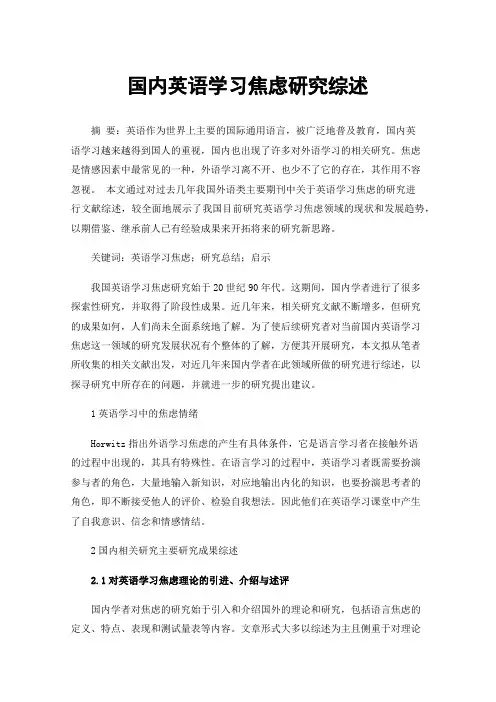
国内英语学习焦虑研究综述摘要:英语作为世界上主要的国际通用语言,被广泛地普及教育,国内英语学习越来越得到国人的重视,国内也出现了许多对外语学习的相关研究。
焦虑是情感因素中最常见的一种,外语学习离不开、也少不了它的存在,其作用不容忽视。
本文通过对过去几年我国外语类主要期刊中关于英语学习焦虑的研究进行文献综述,较全面地展示了我国目前研究英语学习焦虑领域的现状和发展趋势,以期借鉴、继承前人已有经验成果来开拓将来的研究新思路。
关键词:英语学习焦虑;研究总结;启示我国英语学习焦虑研究始于20世纪90年代。
这期间,国内学者进行了很多探索性研究,并取得了阶段性成果。
近几年来,相关研究文献不断增多,但研究的成果如何,人们尚未全面系统地了解。
为了使后续研究者对当前国内英语学习焦虑这一领域的研究发展状况有个整体的了解,方便其开展研究,本文拟从笔者所收集的相关文献出发,对近几年来国内学者在此领域所做的研究进行综述,以探寻研究中所存在的问题,并就进一步的研究提出建议。
1英语学习中的焦虑情绪Horwitz指出外语学习焦虑的产生有具体条件,它是语言学习者在接触外语的过程中出现的,其具有特殊性。
在语言学习的过程中,英语学习者既需要扮演参与者的角色,大量地输入新知识,对应地输出内化的知识,也要扮演思考者的角色,即不断接受他人的评价、检验自我想法。
因此他们在英语学习课堂中产生了自我意识、信念和情感情结。
2国内相关研究主要研究成果综述2.1对英语学习焦虑理论的引进、介绍与述评国内学者对焦虑的研究始于引入和介绍国外的理论和研究,包括语言焦虑的定义、特点、表现和测试量表等内容。
文章形式大多以综述为主且侧重于对理论的阐述而非评介。
范琳、高德新(2005)介绍了情绪调节教学模式及其对第二语言课堂焦虑的调控作用。
2.2英语学习焦虑与英语听说读写技能相关性研究2.2.1英语听力学习焦虑方面的研究近年来焦虑与听力相结合研究层出不穷,研究主要涉及到影响英语学习成效的焦虑因素,而在有关焦虑对英语听力理解的研究和在这方面进行的微观性实验就更不多见。
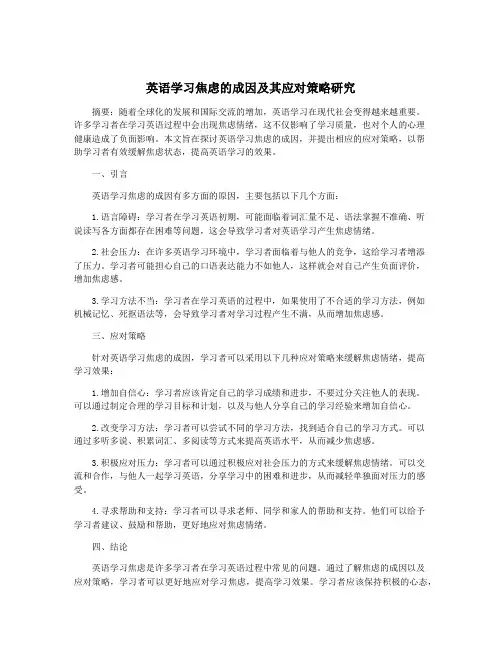
英语学习焦虑的成因及其应对策略研究摘要:随着全球化的发展和国际交流的增加,英语学习在现代社会变得越来越重要。
许多学习者在学习英语过程中会出现焦虑情绪,这不仅影响了学习质量,也对个人的心理健康造成了负面影响。
本文旨在探讨英语学习焦虑的成因,并提出相应的应对策略,以帮助学习者有效缓解焦虑状态,提高英语学习的效果。
一、引言英语学习焦虑的成因有多方面的原因,主要包括以下几个方面:1.语言障碍:学习者在学习英语初期,可能面临着词汇量不足、语法掌握不准确、听说读写各方面都存在困难等问题,这会导致学习者对英语学习产生焦虑情绪。
2.社会压力:在许多英语学习环境中,学习者面临着与他人的竞争,这给学习者增添了压力。
学习者可能担心自己的口语表达能力不如他人,这样就会对自己产生负面评价,增加焦虑感。
3.学习方法不当:学习者在学习英语的过程中,如果使用了不合适的学习方法,例如机械记忆、死抠语法等,会导致学习者对学习过程产生不满,从而增加焦虑感。
三、应对策略针对英语学习焦虑的成因,学习者可以采用以下几种应对策略来缓解焦虑情绪,提高学习效果:1.增加自信心:学习者应该肯定自己的学习成绩和进步,不要过分关注他人的表现。
可以通过制定合理的学习目标和计划,以及与他人分享自己的学习经验来增加自信心。
2.改变学习方法:学习者可以尝试不同的学习方法,找到适合自己的学习方式。
可以通过多听多说、积累词汇、多阅读等方式来提高英语水平,从而减少焦虑感。
3.积极应对压力:学习者可以通过积极应对社会压力的方式来缓解焦虑情绪。
可以交流和合作,与他人一起学习英语,分享学习中的困难和进步,从而减轻单独面对压力的感受。
4.寻求帮助和支持:学习者可以寻求老师、同学和家人的帮助和支持。
他们可以给予学习者建议、鼓励和帮助,更好地应对焦虑情绪。
四、结论英语学习焦虑是许多学习者在学习英语过程中常见的问题。
通过了解焦虑的成因以及应对策略,学习者可以更好地应对学习焦虑,提高学习效果。

大学生英语学习焦虑的类型、成因与自我调节策略摘要:当前,在我国大学生群体当中英语学习焦虑的问题频发,其更是一跃成为了教育首要解决的难题。
若学生在学习英语知识时,产生了焦虑等不良的心理情绪,那么就会阻碍学生的英语能力发展。
对此,应当就大学生英语学习焦虑的类型进行分析,站在全局的立场上,明确大学生英语学习焦虑的成因,结合其成因以及学生自身发展现状,制定出相应的自我调节措施,缓解学生学习英语知识的焦虑感,给大学生后续的学习生活发展提供帮助。
关键词:大学生;英语学习;焦虑类型;焦虑成因;自我调节引言:随着我国对外贸易经济活动的开展,英语这门学科的地位以及价值越来越高,但是学生在英语学习中会受到多种外界因素的干扰,其中影响学生学习的主要因素就是个体情感因素,该因素主要是指学生在学习时期的情绪以及态度。
若学生在使用英语交流时出现焦躁等不良情绪,那么就会让学生逐渐消减学习的兴趣,甚至还会抵触英语知识,需要明确大学生学习英语知识焦虑的成因,对学生的学习现状进行细致化的观察,有针对性的解决焦虑问题,及时的解答学生学习英语知识时期的困惑点。
一、大学生英语学习焦虑类型分析大学生在学习英语知识时,其心理状态不佳,会存在负面性的情绪,无法集中自身的注意力,畏惧并紧张学习英语知识,自卑自怯的心理问题较为严重,同时还会进行自我的否定,严重的还会引发一系列的生理症状例,如身体过敏等。
焦虑情绪的产生会进一步的加剧学生学习的课业压力,在这类双重负担的作用下,学生会产生出厌学、逃课等不良学习问题,甚至还会在学习新英语知识时表现出较强的抵触感。
对当前我国大学生英语学习焦虑的现状进行探究,可以将其焦虑的类别划分成为两类:首先是学生自身个性问题所引发的焦虑情绪,这些学生的性格通常都是较为内向,不会自主地和他人进行沟通,存在社交障碍等的问题,这种焦虑的问题消除难度会比较高,只有当学生自身醒悟之后,才可以达到排解并消除焦虑情绪的目的。
其次是外界因素所形成的焦虑,例如考试压力等。
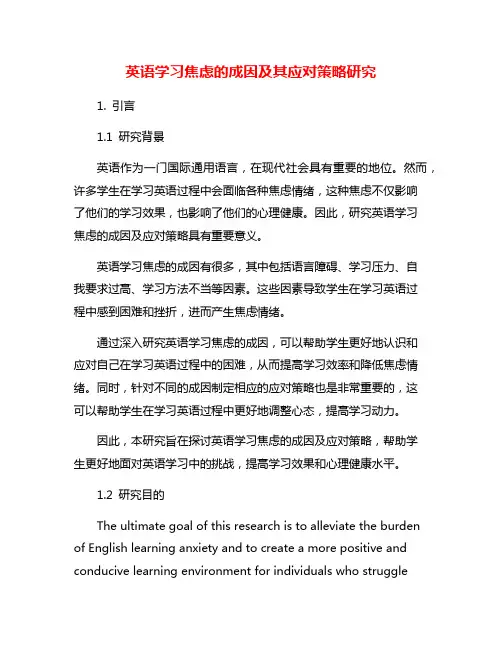
英语学习焦虑的成因及其应对策略研究1. 引言1.1 研究背景英语作为一门国际通用语言,在现代社会具有重要的地位。
然而,许多学生在学习英语过程中会面临各种焦虑情绪,这种焦虑不仅影响了他们的学习效果,也影响了他们的心理健康。
因此,研究英语学习焦虑的成因及应对策略具有重要意义。
英语学习焦虑的成因有很多,其中包括语言障碍、学习压力、自我要求过高、学习方法不当等因素。
这些因素导致学生在学习英语过程中感到困难和挫折,进而产生焦虑情绪。
通过深入研究英语学习焦虑的成因,可以帮助学生更好地认识和应对自己在学习英语过程中的困难,从而提高学习效率和降低焦虑情绪。
同时,针对不同的成因制定相应的应对策略也是非常重要的,这可以帮助学生在学习英语过程中更好地调整心态,提高学习动力。
因此,本研究旨在探讨英语学习焦虑的成因及应对策略,帮助学生更好地面对英语学习中的挑战,提高学习效果和心理健康水平。
1.2 研究目的The ultimate goal of this research is to alleviate the burden of English learning anxiety and to create a more positive and conducive learning environment for individuals who strugglewith this issue. Through our analysis and recommendations, we hope to equip learners with the tools and strategies they need to overcome their fears and challenges in English language learning. By addressing these issues head-on, we believe that individuals can improve their language proficiency and overall well-being, leading to greater success and satisfaction in their language learning journey.1.3 研究意义:英语学习焦虑一直是许多学习者面临的问题,对其进行深入研究具有重要的意义。

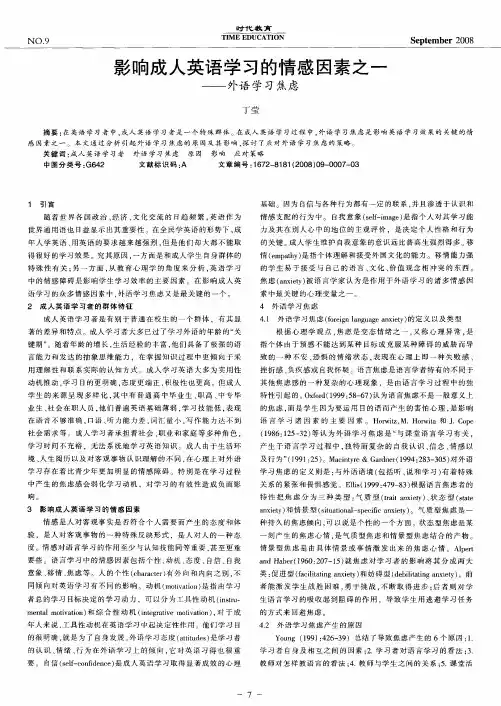
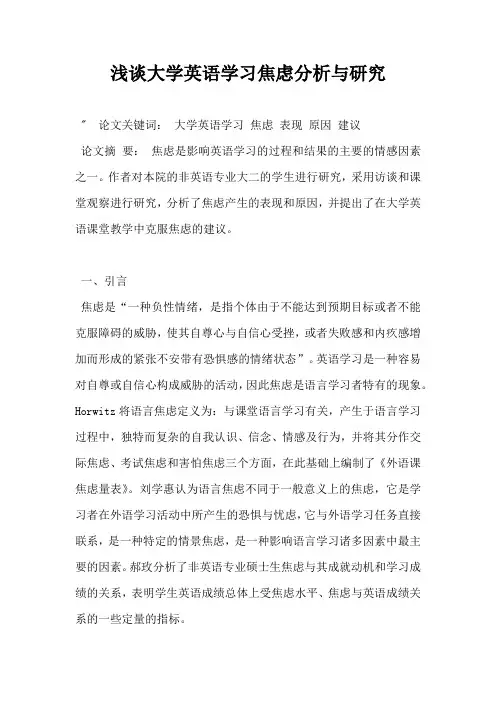
浅谈大学英语学习焦虑分析与研究" 论文关键词:大学英语学习焦虑表现原因建议论文摘要:焦虑是影响英语学习的过程和结果的主要的情感因素之一。
作者对本院的非英语专业大二的学生进行研究,采用访谈和课堂观察进行研究,分析了焦虑产生的表现和原因,并提出了在大学英语课堂教学中克服焦虑的建议。
一、引言焦虑是“一种负性情绪,是指个体由于不能达到预期目标或者不能克服障碍的威胁,使其自尊心与自信心受挫,或者失败感和内疚感增加而形成的紧张不安带有恐惧感的情绪状态”。
英语学习是一种容易对自尊或自信心构成威胁的活动,因此焦虑是语言学习者特有的现象。
Horwitz将语言焦虑定义为:与课堂语言学习有关,产生于语言学习过程中,独特而复杂的自我认识、信念、情感及行为,并将其分作交际焦虑、考试焦虑和害怕焦虑三个方面,在此基础上编制了《外语课焦虑量表》。
刘学惠认为语言焦虑不同于一般意义上的焦虑,它是学习者在外语学习活动中所产生的恐惧与忧虑,它与外语学习任务直接联系,是一种特定的情景焦虑,是一种影响语言学习诸多因素中最主要的因素。
郝玫分析了非英语专业硕士生焦虑与其成就动机和学习成绩的关系,表明学生英语成绩总体上受焦虑水平、焦虑与英语成绩关系的一些定量的指标。
Scovel根据焦虑对语言学习者的影响,将其分为“促进性焦虑”和“退缩性焦虑”。
关于焦虑与学习成绩的关系,一般认为适度焦虑是有利的,它是一种有效活动所必需的激活状态,这时称为“促进性焦虑”;但是高度焦虑对学习产生抑制或者干扰作用,称为“退缩性焦虑”。
他认为,促进性焦虑激励学生征服新的学习任务,使他们不自觉地向目标靠拢;退缩性焦虑则使学生逃避新的学习任务。
二、焦虑研究的数据采集分析我为了更好地分析大学生在学习英语的过程中焦虑产生的原因,对我院非英语专业大二(1)班的学生进行研究,采用访谈和课堂观察采集数据。
我首先在开学第一周进行了访谈,然后做了课堂观察。
1.谈话片段。
学生1:“我本来就是一个容易紧张的人,话也不多,口语也不好,所以特别害怕上课说英语,除非老师点名了,要不然是不会说的。
英语学习焦虑的成因及其应对策略研究导论英语作为国际通用语言,在当今社会中扮演着重要的角色。
许多人都希望能够掌握英语,以便更好地适应全球化的趋势。
尽管很多人努力学习英语,但仍然有不少人面临着英语学习焦虑的问题。
英语学习焦虑是一种常见的心理问题,会影响学生的学习效果和心理健康。
本文试图探讨英语学习焦虑的成因,并提出相应的应对策略,以期能够帮助学生有效地应对英语学习焦虑问题。
一、英语学习焦虑的成因1. 学习压力学习压力是导致英语学习焦虑的主要原因之一。
在当今社会,学生们面临着来自家庭、学校和社会的各种各样的学习压力,他们需要在繁重的课业负担下不断努力学习,以取得更好的成绩。
在这种情况下,许多学生会感到焦虑,担心自己无法应付学习上的压力,这种焦虑也会波及到英语学习中。
2. 考试焦虑考试焦虑是造成英语学习焦虑的另一个重要原因。
在学习英语的过程中,学生需要参加各种形式的考试来测试自己的英语水平。
对于一些学生来说,考试是一种挑战,他们害怕在考试中发挥不好,因此产生焦虑情绪。
3. 自我要求过高一些学生在学习英语的过程中会给自己设定过高的要求,他们希望自己能够立即掌握完美的英语,但由于实际水平与自我期望之间存在差距,因此他们会感到沮丧和焦虑。
这种自我要求过高也是导致英语学习焦虑的原因之一。
4. 缺乏自信缺乏自信是许多学生面临的问题,尤其是在英语学习中。
在和外国人交流时,许多学生会因为害怕发音不准确或者使用错误的语法而感到紧张和焦虑,这种缺乏自信也会成为英语学习焦虑的原因。
二、应对策略学习压力是导致英语学习焦虑的主要原因之一,因此学生需要积极应对学习压力,减轻焦虑情绪。
学生可以通过合理安排学习时间、控制学习进度、寻求帮助等方式来应对学习压力,以缓解焦虑情绪。
考试焦虑是造成英语学习焦虑的重要原因之一,因此学生需要有效应对考试焦虑。
学生可以通过制定合理的复习计划、掌握应对考试焦虑的技巧、进行模拟考试等方式来减轻考试焦虑,以提高考试表现。
成人学生英语写作焦虑及对策研究摘要:对于焦虑的研究不仅心理学界的重大课题,也是教师和教育界十分关注的问题。
本文在一次成人学生英语写作障碍问卷调查分析的基础上,讨论了写作焦虑的实质和成有效性。
认为教师应当帮助成人学生努力降低焦虑程度。
并提出了相关的英语写作对策。
关键词:成人大学生;英语写作;焦虑;对策一、焦虑和外语学习焦虑在课堂教学中所表现出的情绪特征一般为不安、紧张。
它的出现主要是和语言学习者的人格、外语语言学习能力越强,外语语言水平以及学习外语的能力有关。
一般来说,外语水平越高,相对于学习者而来的学习压力就越小,因此,产生学习焦虑感的几率就越小。
对于Woolfolk(2001)而言,焦虑既可以是导致学习任务失败的条件,又可以是学习成绩不好而造成的结果。
因此,我们至少应当从因果两个方面考察焦虑的作用。
SIavm(2003)就焦虑对于学生语言学习的影响总结了大致3条:(1)焦虑影响学生的学习能力;(2)焦虑影响学生运用已经获取的知识;(3)焦虑影响学生的语言测试行为。
从焦虑源的角度看,根据GaMner,Smythe&Glicksman(1976:见Bailley,1995)的总结,焦虑和学生的言语技能水平有关。
也就是说,造成学生学习焦虑的一个因素是语言能力,尤其是语言表述能力;另一个因素是学习任务,包括语言测试;第三个因素是认知能力以及人格。
另外,缺乏自信心,以及对于新环境的不适都可能在一定条件下给学习者造成学习中的焦虑。
二、问题的提出不少成人学生学英语有这样的体会:开始时怕写作文,后来就越写越少,越不写越怕写,越怕写越写不出好作文,因而误人写作怪圈。
为了解成人学生英语写作能力现状,有针对性地开展写作教学,笔者对成人英语专业大二两个教学自然班65位学生作了一次英语写作障碍问卷调查。
调查分成写作训练、写作经历和对写作的看法三大板块,采用无记名方式进行,结果如下:有关英语写作训练的反馈显示约93%的学生写作原因是为了应付考试;写作练习频度随各任课老师要求的不同而不同,能基本做到每周一练者不过1/3,另有1/3学生隔周或每月练习一次,2%的人甚至表示除了考试从不动笔;写作体裁主要集中在各类应试题集内的作文题上,多为应用文和论说文。
焦虑是英语学习过程中最普遍的一种负面情绪状态,是学习者在外语学习过程中,因无法达到预期目标或者遭遇学习困难而形成的。
焦虑是学生在学习过程中常常遇到的一种负面情绪,将在很大程度上降低学生学习英语的兴趣,打击学生学习英语的积极性。
焦虑是自主学习能力养成的消极因素。
有学者将外语学习焦虑分为三个部分:<1)交际焦虑,如自觉参与课堂活动的积极性小,为了逃避老师提问,在课堂提问时,低头沉默,避免跟老师目标接触等;(2)考试焦虑:如有的学生考前紧张不安,甚至影响正常的饮食和睡眠,无法摆脱恐惧、害怕失败的心理情绪,导致考试中不能发挥正常水平,成绩不理想,带来恶性环;C3)负评价焦虑:害怕面对评价,畏惧他人对自己做出的消极的评价。
①焦虑的产生大多与学生过去的学习经历相关关,是失败的学习经理过程中,学生所遭遇的负面情绪带来的不良反应。
焦虑的情绪通常使得学生无法思考、心烦意乱,惧怕参与到语言活动中去,为了保护自我形象和情感,学生就会采取退缩的行为,比如逃避参加班级课堂活动或小组活动,甚至会产生厌学情绪。
②这将对学生学习英语的积极性和主动性产生重大损害,从而不利于学生英语自主学习的能力的培养。
更多扩展阅读:。
中国成人英语学习的焦虑变量分析作者:张慧JiLin University吉林大学2000年3月Master’s Degree ThesisAn Analysis of Apprehensive Variables inEFL for Chinese AdultsMajor: English Linguistics & LiteratureAuthor: Zhang HuiSupervisor: Prof. Liu XiyanDept. of English, College of Foreign LanguagesJiLin UniversityMarch, 2000CONTENTS INTRODUCTION (1)1. ANXIETY AND ITS EFFECTS ON SECOND LANGUAGE ACQUISITION ( SLA) (1)1.1 L ANGUAGE A NXIETY & C OMMUNICATION A PPREHENSION (2)1.2 A PPREHENSIVE E FFECTS ON SLA (3)2. APPREHENSIVE VARIABLES IN EFL FOR CHINESE ADULTS (3)2.1 L EARNER-INTERNAL F ACTORS A FFECTING A NXIETY IN A DULT SLA (ALA) (4)2.1.1 Anxiety Caused by Cognitive-Processing Elements in ALA (4)2.1.2 Anxiety Caused by Strategy-Adopted Elemnts in ALA (6)2.1.3 Anxiety Caused by Self-Related Elements in ALA (9)2.2 A PPREHENSIVE V ARIABLES IN EFL FOR C HINESE A DULTS (12)2.2.1 Anxiety Induced by Natural Conditions in EFL in China (13)2.2.1.1 Natural Conditions Restricted to Limits on Linguistic Exposure................................ (13)2.2.1.2 Natural Conditons Restricted to Deficiencies in Educational Situations (15)2.2.2 Anxiety Induced by Empathic Capacity in EFL in China (16)2.2.2.1 Anomie Aroused by Language Shock and Cutural Shock (17)2.2.2.2 Inhibiton Aroused by Introverted Personality (18)2.2.3 Anxiety Induced by Low Self-efficacy in EFL in China (19)2.2.3.1 Self-Efficacy Reduced by Chinese Low Self-Esteem in EFL (20)2.2.3.2 Self-Efficacy Reduced by Chinese Learned-Helplessness Underlying Their Attribution (21)3. PEDAGOGICAL IMPLICATIONS AND SUGGESTIONS TO DISPEL ANXIETY (25)3.1 P EDAGOGICAL I MPLICATIONS (25)3.2 S UGGESTIONS TO DISPEL ANXIETY (27)CONCLUSION (30)REFERENCES (31)ABSTRACT (1)An Analysis of Apprehensive Variables inEFL for Chinese AdultsIntroductionWithin the last few decades, based on the values of humanistic education and student-centered approach, several affective-based teaching methods including Curran’s Community Counseling, Lozanov’s Suggestopedia, Asher’s Total Physical Response and Terrell’s Natural Approach, began to pay much more attention to the learner’s emotional stages. They have been developed as successful techniques to induce in learners a state of mental relaxation and comfort intended to maximize language acquisition. Contrarily, the emotional reverse of “relaxation”is known as anxiety.Anxiety is one of the important affective variables identified in "Krashen’s Affective Filter Hypothesis". Generally speaking, affective variables are those factors that deal with feelings, the emotions of pleasure and displeasure that surround the enterprise of task, such as, second language learning. They mainly deal with the emotional reactions and motivations of a learner and signal the arousal of the limbic system and its direct intervention in the task of learning.Internal to learners, anxiety is an emotional response, a kind of apprehensive state aroused by the attempts to learn a foreign language which strongly influence the learner’s Second Language Acquisition (SLA). In combination with motivation and self-concept, anxiety, as a debilitating factor, affects what a learner admits for further processing. In China, language anxiety has been an obstacle in English as a foreign language (EFL), especially for adult learners.Many factors cause anxiety. In comparison with a child's acquisition, adults experience more anxiety because they face greater difficulty due to the potential effect of age, cognitive growth, increasing self-consciousness and differential environments between the first language (L1) and the second language (L2). Besides, some internal factors of learners, such as, self-perception, cognitive processing and communication strategies should also be considered.In China, the problem of anxiety appears to be more acute. In this thesis, the apprehensive variables in adult SLA (ALA), especially in EFL for Chinese adults are analyzed in great detail, focusing on China’s special characteristics, both culturally and environmentally. Meanwhile, some pedagogical suggestions are also given in combination with the effect of motivation and self-concept in EFL.1. Anxiety and Its Effects on SLAAs a filter element, anxiety is one of the important affective variables that affect SLA negatively. There are so many kinds of anxiety: test anxiety, classroom anxiety, social anxiety, reticence and so on. Here, in terms of EFL for Chinese adults, only language anxiety andcommunication apprehension are concerned in this thesis.1.1 Language Anxiety & Communication ApprehensionIn the course of foreign language learning, many learners, especially adult learners, claim to have a kind of mental block or apprehensive reaction that impedes their ability to perform successfully in a foreign language situation. Such an apprehensive state, a kind of vague fear that is only indirectly associated with an object, is termed as anxiety by psychologists. Language anxiety is only one of several types of anxiety that have been identified by psychologists.Language anxiety is " a type of anxiety unique to second language learning and conceived of as something more than the sum of its component parts." (Horwitz 1991, P.26) It can be defined as “the feeling of tension and apprehension specifically associated with second language contexts, including speaking, listening, and learning.”(MacIntyre & Gardner 1991b)In general, there are two approaches to the description of language anxiety: (1) language anxiety may be viewed as a manifestation of other more general types of anxiety. For example, a test-anxious learner may feel apprehensive when learning a language because he feels constantly tested; (2) language anxiety may be seen as a distinctive form of anxiety expressed in response to language learning, that i s, something unique to the language learning experience makes some individuals nervous. Generally speaking, foreign language anxiety is considered as a distinct complex of self-concepts, beliefs, feelings and behaviors related to SLA arising from the uniqueness of the language learning process.There are many types of language anxiety such as test anxiety, fear of negative social evaluation, communication apprehension, etc.. Among them, communication apprehension is the common one, especially for Chinese adults in EFL.Communication apprehension is a type of shyness characterized by "fear of or anxiety about communicating with people." (Horwitz 1991) The difficulties in speaking in dyads or groups (oral communication anxiety) or in public (stage fright) or in listening to or learning a spoken message (receiver anxiety) are all manifestations of communication apprehension.Communication apprehension or some similar reaction obviously plays a large role in language anxiety. People who typically have trouble speaking in groups are likely to experience even greater difficulty speaking in a foreign language class where they have little control of the communicative situation and their performance is constantly monitored. Moreover, in addition to all the usual concerns of oral communication, the foreign language class requires learners to communicate via a medium in which only limited facility is possessed. The special communication apprehension permeating foreign language learning comes from the personal experience one has in understanding others and making oneself understood. Possibly because of this experience, many otherwise talkative learners are silent in a foreign language class. Here, due to its emphasis on interpersonal interactions, "the construct of communication apprehension is quite relevant to the conceptualization of FL anxiety." (McCroskey, 1977). Actually, communication apprehension hasmany logical ties to foreign language (FL) anxiety because it represents the anxiety experienced by many people even when communicating in their first language. Since the characteristics of FL anxiety in EFL for Chinese adults are mainly reflected in the form of communication apprehension, it’s necessary to probe further into its causal variables.1.2 Apprehensive Effects on SLAAs an emotional state, anxiety is generated through the arousal of the limbic system, the primitive, subcortical state of the cerebrum, which plays an important, though indirect, role in many kinds of human enterprises, including communication. Therefore, anxiety is "the subjective feeling of tension, apprehension, nervousness, and worry associated with an arousal of the autonomic nervous system." (Spielberger, 1983). As an effect of these responses, anxiety will distract from the task of attending to and remembering new items. It discourages the practice that will establish new items.Although anxiety can play a favorable facilitating role in some cases, it fails learners' performance as it is a kind of interference. Where SLA is concerned, language anxiety has been found to be an obstacle to foreign language learning. In fact, many second language researchers have long been aware that anxiety is often associated with language learning in a negative way. It has been found that low achievers show emotional, inner conflict or anxiety. Recently, it has been hypothesized that anxiety plays a role in success or failure in FL classroom. Young (1989) believes that the anxiety in FL classroom occurs primarily because the student has to speak the FL in front of a group. Horwitz and Cope (1994) suggest that there is likely to be a strong negative correlation between FL anxiety and FL proficiency, that is, as FL proficiency increases, anxiety decreases. Therefore, a conclusion can be drawn that language anxiety plays a negative role in foreign language learning. This can be further evidenced by the case of EFL in China where most adults have experienced communication failure in anxiety conditions. Thus, anxiety will be discussed as a specific type of debilitating factor in EFL for Chinese adults in this thesis.Since language anxiety has so profound an effect on many aspects of foreign language learning, it’s important to identify its main components. Hence, an analysis of such causal variables of anxiety in ALA, especially in EFL for Chinese adults will be made next.2. Apprehensive Variables in EFL for Chinese AdultsTo analyze the apprehensive variables in EFL for Chinese adults, it is necessary to explore the causal factors of anxiety common to adult learners. This is because, in SLA, in comparison with children, adults will face more difficulties that arise from the differences of acquisition in such aspects as:Cognitive differences: native language is acquired in an unconscious and automatic fashion. Children are exposed to language data on an unorganized basis and they develop language in tandem with cognitive and maturational development. In contrast with it, SLA is a conscious and controlled process that occurs on an organized basis. In addition, second language learners, being older, are more capable of formal grammatical reasoning.Contextual differences: native language is acquired in a “natural”environment, whereas the second is generally learned in an “artificial”environment, the classroom. The acquisition of one’s native language occurs without any organized pedagogical intervention, except for occasionally controlled language input of adults. A second language learning is assimilated directly by pedagogical activities and is characterized by formal learning procedures.Motivational differences: first language acquisition comes naturally and not as a result of the discovery of its practical utility. Second language learners, however, must be motivated to learn a new language thus producing different expectations and results according to different motivational factors.To sum up, these differences force adults to experience more difficulties in SLA. Besides, some internal factors of adult learners themselves should also be noticed.2.1 Learner-Internal Factors Affecting Anxiety in ALAV olumes of anxiety researches have demonstrated the pervasive influence that anxiety can have on “cognitive, affective and behavioral functioning.”(MacIntyre & Gardner 1991) Having recognized this point of view, the further detailed discussion will be made concerning the learner-internal factors in which some cognitive-processing elements (cognitively), strategy-adopted elements (behaviorally) and self-related elements (emotionally) are involved.2.1.1 Anxiety Caused by Cognitive-Processing Elements in ALAWhen linguistic input is received by learners, it will be processed through a series of procedures such as editing, filtering, processing and monitoring so that the new language material can be eventually output. During this process, anxiety, as one of the important affective variables, determines how much the language input will be filtered and even affects the ultimate acquisition of language, thus playing a key role.However, it has been suggested that "anxiety causes cognitive interference in performing specific tasks, such as communication apprehension." (Schwarzer, 1986), which can be explained as a cognitive process seen at three stages: input, processing and output.The input stage i s concerned with the initial representation of items in memory. At this stage, external stimuli are encountered and internal representations are made; attention, concentration and encoding occur. Because fewer items are available for processing or later retrieval, anxiety-arousal at this stage has an impact on all subsequent stages. For example, in SLA, difficulty may arise if the language is spoken too quickly. Thus, at the input stage, anxiety may be caused due to attention deficits or poor initial processing of information.Therefore, people with high anxiety are easily distracted from the task because time is divided between the processing of emotion-related and task-related cognition. As for adults in SLA, if they have disadvantages of poor listening c omprehension, vocabulary deficits or cultural-background ignorance, they will be involved in the dilemma of misunderstanding, missing part of the input, being confused or even totally lost in the input transmitted in the target language. Thus, they willsuffer from input anxiety, a kind of apprehension experienced when listening in the communication. Take Chinese adults for instance, most middle-aged learners suffering greatly from poor listening comprehension can hardly follow those who speak too quickly so that anxiety is probably arousedin the form of communication apprehension or receiver apprehension. Such situations are usually reported as: “I get flustered unless English is spoken very slowly and deliberately.”or “I get upset when English is spoken too quickly.”… It is also found that the occurrence of auditory problems is related to the input stage. That is, the difficulties of sound discrimination and sound-symbol aspectsof language are largely responsible for those FL learning problems and arouse anxiety eventually.The processing stage involves the cognitive operations performed on the subject matter: organization, storage and assimilation of the material. This stage involves unseen, internal manipulations of items taken in at the input stage. Therefore, latency is the primary indicator of activity at the processing stage and potentially causes anxiety. Tobias (1986) claimed that anxiety impairs cognitive processing on tasks that are more difficult, more heavily reliant on memory and more poorly organized. Each of these increases not only the demands on processing time but alsothe possibilities of generating anxiety. In a second language context, the time taken to understand a message or learn new vocabulary would dictate the degree of activity at this stage. Consequently, atthe processing stage, as the task becomes more difficult relative to ability, anxiety shows greater impact on processing. Interference with the rehearsal of new information is an example of this typeof effect.In contrast with children, the processing stage appears to be more complicated for ALA because of their conscious learning, which can also be evidenced by Krashen’s Monitor Model. It claims that a second language performer can use conscious rules only when three conditions have tobe met. That is, only when he has: (1)time to inspect the utterance before it’s spoken, (2) to be consciously concerned about correctness and focus on the form, (3) to know the rule.However, in most cases, such as, in a natural conversation, all of these conditions can rarely be met. Normal conversation tends to be quite rapid and does not allow time to think about and use rules. The speaker’s attention is usually on what is being said, not on how it is being said. In addition, the learner’s conscious knowledge of grammar covers only a small portion of the rules ofa language since the structure of language is extremely complex. It can be said that adult learnersare exposed only to a small part of total grammar of a language. Therefore, this rarely-actualized operation of a monitoring function further strengthens the effect of anxiety at this stage.Meanwhile, as formal learners, adults seldom have sufficient time for the intrusion of their consciously learned knowledge. When the conscious monitoring process is being operated and progressed, the time of processing stage is also extended at the same time so that it has to be shortened accordingly at the next stage. In the end, inefficiency or failure may be generated due to this time limitation, which further enhances the learner’s anxiety level.Unlike adults characterized as “formal thinkers”, children acquire language in situations that appear to be “monitor-free”. They only focus on communication rather than on linguistic form. Besides, having benefited from absence of self-consciousness, children are less aware of thedifferences between the two language systems and rarely apply the first language structure to the learning L2 structure so that their processing stage is more simplified than that of adults. In so doing, on the other hand, children also create fewer errors derived from L1 interference. As a result, children experience less apprehension than adults when learning a second language.Output involves the production of the previously learned material. Performance at this stage is highly dependent on the previous stages, in terms of the organization of the output and the speed at which items are retrieved from memory. It is at this stage that learners are required to demonstrate their ability to use the second language. Performance at the output stage can be measured by test scores, verbal production, and the qualities of free speech.The output anxiety can be universally found in the cases of EFL in China. Even though Chinese adults are excellent in writing competence or have a large vocabulary, they still find themselves rather awkward, stupid or even frozen in communication. Sometimes, although they have an idea of the semantic meaning of an English word, they still fail to verbalize it forgetting or being innocent of the authentic expressive way in the target language by means of “phonetic entity”. Therefore, anxiety may interfere with the retrieval of the previously learned knowledge and the experience of “freezing”on an oral production can be attributed to the influence of anxiety at the time of retrieval. That is also the source of “just on the tip of the tongue.”It has been suggested that these three stages are interdependent and each stage depends on the successful completion of the previous one. For example, the difficulty in the performance at the output stage may be caused by deficits created at the input or processing stage. Therefore, the negative correlation between language anxiety and the second language production may be indicative of problems at any of the three stages, thus, generating language anxiety accordingly. Meanwhile, the combined effects of language anxiety at these three stages may conversely influence the adult learners who have a smaller base of second language knowledge and have more difficulty demonstrating the knowledge that they do possess, thus causing new anxiety as a result.2.1.2 Anxiety Caused by Strategy-Adopted Elements in ALAEysenck (1979) suggests that anxiety disrupts cognitive processing but that increased effort can compensate for the effects of anxiety on the quality of observed performance. Therefore, in SLA, adults always try to compensate for the negative role played by anxiety which are embodied in the adoption of various strategies. However, restricted by inadequacy of L2 knowledge and poor communicative competence, these strategies are usually abused thus negating the efforts, functioning conversely and decreasing the quality of performance. Eventually, these abuses of strategies result in increased anxiety.Since strategies vary intra-individually, each of the learners has a whole host of possible ways to solve a particular problem from learning, production and communicating strategies in the process of both acquiring and using L2.1) learning strategiesLearning strategies refer to the ways in which the learner consciously and subconsciouslyprocesses second language input. Here, strategies as varied as pattern memorization, overgeneralization and intolerance of ambiguity have been treated under the general heading of learning strategies.a. pattern memorizationMany learners develop formulas as a response to communicative pressure. That is, they memorize a number of ready-made expressions to compensate for lack of suffici ent L2 rules to construct creative speech, thus forming a kind of formulaic speech that has been observed to be very common in classroom learners.It should be admitted that, in the early SLA, this strategy could reduce the learning burden while meeti ng the basic communicative need. The important point, however, is that it is restricted to the performance of a specific meaning in a certain context. Once the communicative need is increased, it is possible, therefore, that the pattern or formula is hardly unpacked so that valuable information can not be fed into the creative rule system for the immediate production and reception. Consequently, the learner will be at a loss to “what/how to say”and fail in communication, causing certain apprehension.b. overgeneralizationThe strategy of syntactic overgeneralization can be defined as "a process in which a language learner uses a syntactic rule of the target language inappropriately when he attempts to generate a novel target language utterance." (Taylor 1975 P.74) A learner relies on what he has already known when confronted with a new learning situation and as he learns more about the target language, his reliance on his native language will decrease, the errors attributable to the target language syntactic overgeneralization will increase. Noticeably, many errors attributed to the inherent difficulties and irregularities in the target language itself can be explained by the strategy of the target language syntactic overgeneralization. Thus, these errors, regardless of their sources, will be generated sooner or later. Once learners are aware of the occurrence of errors, they will inevitably produce anxiety.c. intolerance of ambiguityIntolerance of ambiguity is the tendency to perceive such situations o f novelty, complexity or insolubility as unacceptable. In fact, intolerance of ambiguity appears to be more experienced by adults than children who are found to be amazingly indifferent to contradictions. As for adults, their intellectual growth produces an awareness of ambiguities about language and heightens the need for resolution.A general intolerance of ambiguity produces an acute awareness of the myriad differences in two languages for an adult performer so that the prospect of learning a second language suddenly becomes overwhelming, discouraging him from proceeding a step at a time as a child would do. Thus, the intolerance of ambiguity derived from an adult’s cognitive growth involves him in unacceptable, ambiguous situations with disappointment, depression or anxiety.2) production strategiesProduction strategies comprise the learner’s attempts to use the L2 knowledge they haveacquired in an efficient way. The example is the overuse of Monitor.In SLA, difficulties arise when performers become over-concerned with correctness in communicative situations, trying to check their output against conscious rules at all times and such performers become the Monitor over-users. The overuse of Monitor reveals the user’s lack of faith in his acquired knowledge of the target language. In nature, it stems from a simple lack of acquisition.In general, the overuse of Monitor results in hesitancy and subsequent difficulty in participating in conversation, thus creating the learner’s anxiety.3) communication strategies (CSs)CSs generally are devices employed by L2 learners when they encounter problems in L2 communication because their communicative ends have outrun their communicative means. Such devices can be shown as avoidance, repetition, lack of mimicry and literal translation.a. avoidanceIn communication, when a learner refuses to produce some necessary items he doesn't know or when he feels the likelihood of making errors, he will usually adopt avoidance as a strategy. In so doing, he is forced into coping with both the linguistic and communicative needs by other means, such as by circumlocution, which raises greater possibilities of making errors. After much avoidance, when these “evaders”find themselves in the situations where communication is required, they are less likely to do well than their more skilled counterparts so that new anxiety will be induced. This indicates that the more an anxious learner is, the more avoidance he will tend to adopt, thus conversely increasing his anxiety level.b. repetitionIn communication, sometimes, to avoid stopping the communication task, learners would rather carry on the communication task by repeating what they have said than simply take steps of avoidance.Repetition is extensively used when a leaner fails to understand others' intended meaning or when he has neither sufficient linguistic knowledge nor general knowledge upon which to rely. He will just keep on repeating what he has said in the hope that the inter-locator would strive harder to work out his intended meaning.Repetition enables learners to keep the communication channels open and to appear less embarrassed by avoiding the stopping of the conversation. However, similar to avoidance, which is not an efficient way to solve problems, repetition will eventually involve learners in the dilemma with further immediate information processing. Anxiety will thus be caused as a result of repetition in the communicative dilemma.Noticeably, by analyzing Chinese learners’characteristics, it has been tentatively inferred that “repetition CSs are specific to Chinese learners or learners with the same characteristics.”(Chen Si Qing 1990 P.173)c. lack of mimicryIn learning a new language, mimicry is a very important strategy for learners in gainingaccuracy of the target language. The one who becomes the best mimic learns most rapidly and achieves the best result.It is, however, not easy to gain such accuracy. A learner must be willing to give himself whole-heartedly to the strenuous business of learning the new language and must throw off all restraint and self-consciousness as far as the making of strange sounds is concerned. This is particularly difficult for adult learners compared with children because of the deficiencies of flexibility of both ps ychomotor skills and language attitude. Consequently, it’s quite hard for them to accept the target language and its culture by pure imitation, supposing that they reject all that is familiar to them. Thus, the lack of mimicry will necessarily affect adults' achievement of accuracy in the target language and increase their anxiety without understanding the idiomatic use of the target language.d. literal translationThe automatic habit of learning a new language is not as easy for adults as for children. Being haunted by the increased self-consciousness and greater sensitivity to fine discrimination of his own language, an adult will inevitably interpret the new language symbol through his accepted language symbols as a result of his experience. He is likely to develop such a strategy of literal translation by the practice of seeking word equivalents from his own language when he has established a direct connection between his experience and the new language.Literal translation or “word equivalents”, which seems to save time at the beginning, really causes great inconvenience in the long run because the automatic processing is actually delayed when the learner adopt this strategy by means of finding corresponding items or word equivalents between the two language systems. It may confuse learners or even get them into such habits as to thwart any real control of the new language and as a result, affects the fluency of spontaneous communication. Also, it causes inaccuracy in the use of the target language so that the cultural knowledge could probably be ignored or abused due to the inappropriate blunt match between the two languages. In this sense, literal translation is also the potential of communication apprehension.In conclusion, all of these above-mentioned strategies can be regarded as potential sources of anxiety in the different aspects in ALA, such as communication or situational apprehension. (see table 2.1)2.1.3 Anxiety Caused by Self-Related Elements in ALAThe generation of anxiety is associated with the inference of self-related elements such as excessive self-evaluation, worry over potential failure and concern over the opinions of others. An anxious person thus has his attention divided between task-related and self-related cognition, making cognitive performance less efficient. This can also be used to explain the negative effects of self-related elements observed in language anxiety, which will be expounded in three aspects:1) inhibition from language egoAs the very personal egoistic nature of SLA, language ego is defined as "the extent to which one’s self-concept is inextricably bound up in language." (Brown, 1991, P.77) In fact, the。